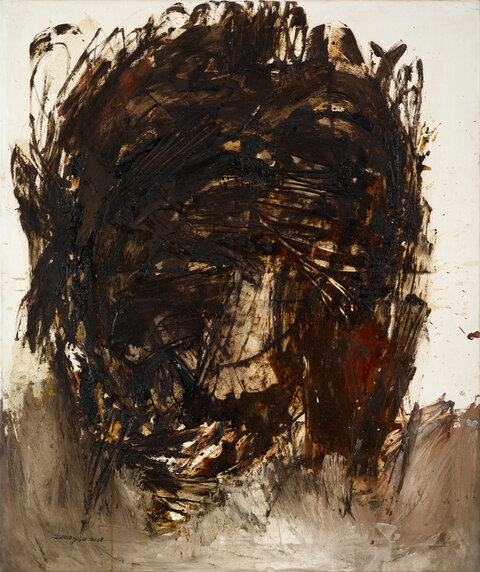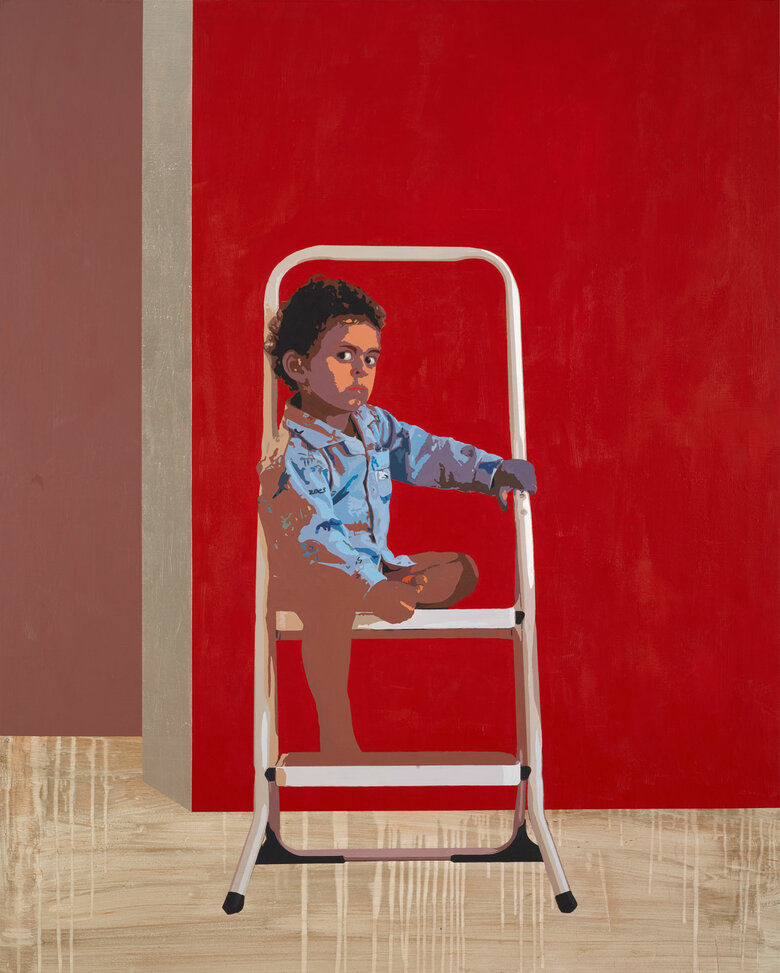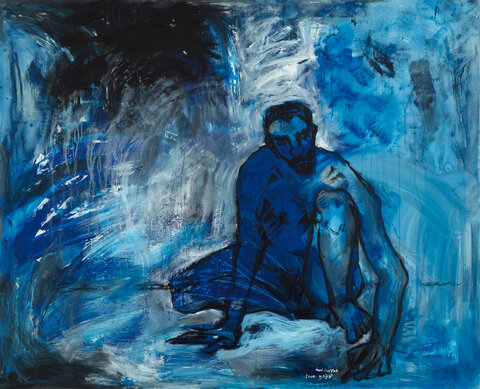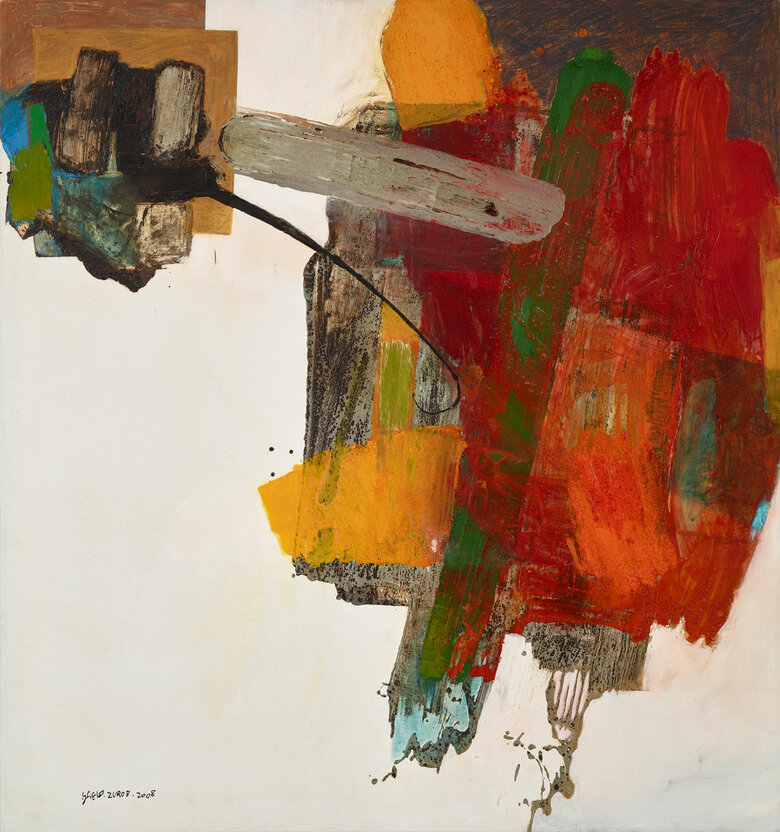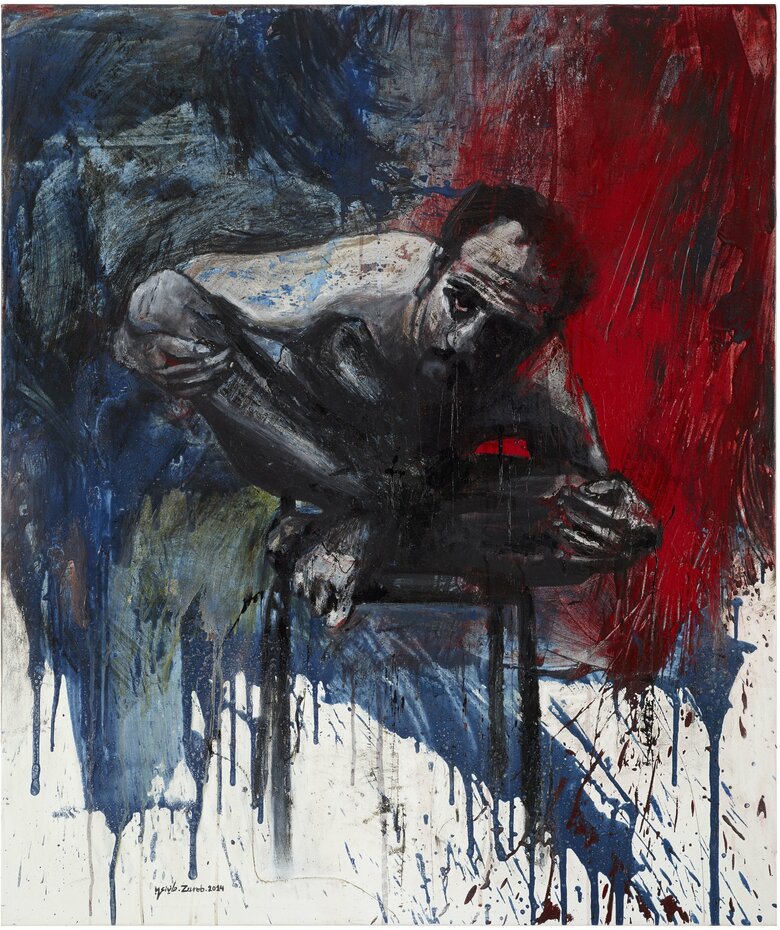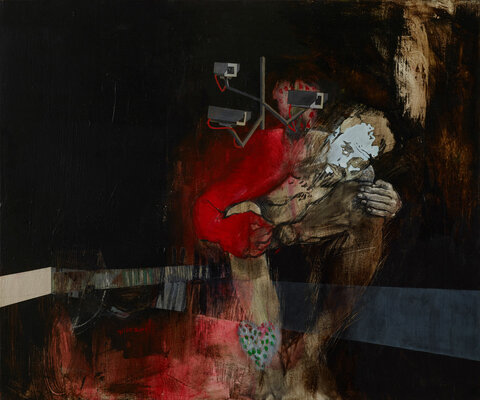Hani Zurob was born in Gaza’s Rafah refugee camp in 1976. He grew up in the home his father had inherited from his parents, who were expelled from Wadi Hunayn in 1948 and forced to relocate to...
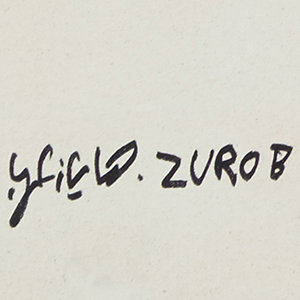

HANI ZUROB, Palestine (1976)
Bio
Written by WAFA ROZ
Hani Zurob was born in Gaza’s Rafah refugee camp in 1976. He grew up in the home his father had inherited from his parents, who were expelled from Wadi Hunayn in 1948 and forced to relocate to Gaza. One of seven children, Zurob, graduated from Al-Samaw’al Secondary School in the camp and earned a BA in Fine Arts in 1999 from Al-Najah National University in Nablus. In 2006, he moved to Paris, where he remains exiled to this day.
For most of his life, Zurob felt trapped. Growing up in the increasingly crowded Gaza Strip, his movement was always limited, but he experienced the acute sensation of entrapment for the first time in 1987, at the age of twelve; in response to the outbreak of the First Intifada, Israeli authorities imposed a curfew that left the restless boy stuck at home for days on end. During this time, Hani spent hours illustrating images from his father’s books and periodicals, developing his skills as a draughtsman, and soon, he applied these talents to making posters in support of the Intifada. Known for his remarkable Arabic calligraphy as well as his proficiency in drawing, he contributed to the resistance as a graffiti artist, participating in demonstrations and plastering his surroundings with nationalist slogans. Influenced by his formative years as a teenager during the uprising, his art has continued to reflect upon the Palestinian narrative as a whole, in addition to his personal experiences.
Hani left Gaza in 1994 to pursue a college education in Nablus. Like most Palestinians seeking to leave Gaza, Zurob did not have an easy time of it, as the Israeli authorities refused him an exit permit. The determined artist nevertheless found his way to Nablus after being smuggled into East Jerusalem; he completed his degree as an illegal resident, facing the constant threat of deportation. After graduating, he worked in graphic design in Nablus and taught art in the district of Jenin, ultimately landing a job as an instructor at a women’s college in Ramallah. When Zurob moved to Ramallah to start work in 2000, he was excited to be based in a hub of Palestinian art and culture, but his life was yet again disrupted by civil unrest. During the Second Intifada, which erupted that same year, the Israeli Defense Forces (IDF) invaded the West Bank. When, in 2002, Ramallah fell under siege, Prime Minister Ariel Sharon imposed curfews on its residents, and troops detained any individuals they deemed suspicious. That year, Israeli soldiers raided Zurob’s apartment, destroyed his paintings and art supplies, and arrested him as an illegal resident in Ramallah. The artist was detained at Ofer prison for 53 days, enduring torture when he allegedly refused to cooperate with Israeli intelligence; an interrogator broke his hand in a deliberate attempt to end his career as an artist. When Israeli prosecution failed to indict him on serious charges, he was eventually released from prison, but ultimately received a notice of deportation from Ramallah.
Before his detention, Zurob had entered the AM Qattan Foundation’s 2002 Young Artist of the Year Award (YAYA). Having lost his tools and work, and having sustained a severe injury to his hand, he tried to withdraw upon leaving prison. Given the circumstances, however, the foundation granted him a two-month extension, during which he created a body of work entitled When I Say No, I Mean No (2002). The work reflected on his brutal incarceration and was later selected for an exhibition of the ten award finalists.
Having returned to living illegally to Ramallah, Zurob found himself between a rock and a hard place, yet he was able to attend exhibitions and cultural events that were rare in Nablus and unthinkable in Gaza. For the first time, he was exposed to contemporary artwork by international artists such as Aurore Millet Reinecke and Thomas Kilpper, whose work inspired him and connected him to an international community. It was in Ramallah that Zurob met his mentors, Muhammad Saleh Khalil and Samir Salameh, who granted Zurob access to their libraries and thus opened his eyes to a broader global sphere of artwork. On the other hand, the artist felt alienated in Ramallah, and his precarious legal status made traveling impossible. Anxious to avoid deportation, he limited his movement to an area of five square kilometers within the city.
The marriage of these circumstances led to one of Zurob’s best-known series, Siege (2004-2006). Lonely and isolated, the artist moved away from Palestinian nationalist themes and imagery, looking inward instead to confront his sense of entrapment. The compositions show vibrant, primary colors of acrylic on canvas, applied in loose, dynamic brushstrokes to buzzing swaths of color and large central figures. The artist based these figures on himself, using two mirrors to help him realize their warped perspective, and his use of bold charcoal lines provides a solid, grounded contrast to the fluid motion of the paint. The graphic contours of his lines and the expressive contortions of his figures evoke the self-portraits of Austrian painter Egon Schiele, with whom the artist grew fascinated through the books he borrowed from Salameh and Khalil.
Hani Zurob created Siege No. 4 in 2004, during a workshop organized by the newly-founded Palestinian Association for Contemporary Art. The large-scale canvas reflects on Zurob’s experience of incarceration two years prior, showing the naked artist crouching against an abstract, indeterminate background. The painting is executed in shades of blue from indigo to aquamarine, lashed with whites and the dull black of charcoal; these melancholy colors deepen the sense of vulnerability that exudes from the hunched figure. Though the fourth of the series, it is the first to show the artist’s face frontally. With one hand resting on the floor and the other grasping a drawing tool, the artist announces his presence by meeting the eyes of the viewer, his gaze at once defiant and exhausted.
In February 2006, the Cite Internationale des Arts offered Zurob a grant to study in Paris. There, he produced a series entitled Sortie (2006), inspired by his early experiences in the city; Sortie, which means “exit,” was the first word the artist learned in French, committed to memory as a result of using the metro. His use of French, though playful, reflects the dual state of mind through which Zurob operated in Paris. As he had escaped Gaza only to feel alienated in the West Bank, he had traded the challenges and traumas of occupied Palestine for the estrangement of living in a foreign environment. The Sortie paintings exemplify how, during this period, Zurob straddled boundaries between figuration and abstraction, favoring sober colors like black, white, umber, and olive. Their wide, gestural brushstrokes and abstract compositions are punctuated with found objects, and foreign textures applied directly to the canvas, including metro tickets, coins, fiber mesh, and metal rods.
Having been issued an eviction notice from the city years ago, Zurob could not return to Ramallah and found himself stuck in Paris. By the end of 2006, his wife Sabreen Daoud joined him there, and as the couple began their life abroad, Zurob returned to Palestine through his work. In series of sixty paintings, Standby (2007-2008), Zurob reflected on the sixty years that had passed since the Palestinian nakba –sixty years during which these same Palestinians were guaranteed the right of return by international law, yet were never able to claim it. The works feature black-outlined figures based on nude photographs of the artist seated in eight different positions. The figures are painted dynamically, with some lines bearing the measured lucidity of Siege and others erupting into looser, more chaotic forms, and the canvases are spattered in acrylic blues, reds, browns, and ochres that are muddied by the inclusion of henna and black tar. During this period, Zurob was inspired by a memory of Gaza to start using black tar as a principal medium (see, for example, Standby nos. 10-19).
Tar has significance for Zurob, who recalls a day during the first Intifada (1987-1993) when he left his house in Gaza after 40 consecutive days of isolation imposed by the Israeli curfew. “I will never forget that morning,” the artist has stated, “when I stepped outside to discover that Israeli soldiers had covered everything in bitumen. The streets, shop windows, façades of houses, everything was in bitumen, including the trunk of the palm tree in my neighborhood.” Zurob has also linked the use of the black substance to his time in a West Bank detention center during the second Intifada (2000-2003). At the time, Israel was arresting so many Palestinians that it ran out of space in its prisons, and placed recent detainees in newly-made tent-like structures surrounded by barbed wire. The floors of these spaces were made of asphalt; forced to sleep on one, Zurob grew accustomed to the smell of freshly-poured bitumen.
Building upon the formal qualities he explored in Standby, the series Zeft (2017) represents the hardship and stagnancy of life in Palestine. Zeft means tar in colloquial Arabic, and it is used to describe misfortune or worthlessness. To mitigate the thick and sticky nature of tar, Zurob created his own mix with the help of a chemist in France by diluting the substance with an acrylic binder. This technique is responsible for the shiny, waxy quality of the finished abstract works. In another series Zeft Land (2019), he mixed tar with paint and incorporated gold leaf and earthy materials such as tree branches, twigs, and dry flower petals into his paintings.
In addition to reflecting on the conditions of Palestinian life, Hani Zurob’s art tackles more mundane, universal subject matter. For example, a 2015 solo exhibition entitled Low Quality Love addressed another type of alienation, namely communication in the digital age. To this, the artist commented that “we live in a heartless world defined by injustice.” In this exhibition, Zurob responded to Peter Doig’s eerie 1997 painting Canoe Lake with Excuse me Peter Doig: this is Canoe-Sea (2015). While Doig’s original features a female figure in a canoe and is painted in bright, almost phosphorescent greens, Zurob’s shows an oversized human heart, rendered in deep, cool reds, in an ochre canoe against a muted, tranquil sage green background. Lacking both oars and arms to row them, the heart is adrift in an unidentifiable sea, unable to move itself towards or away from anything.
Hani Zurob’s wife, Sabreen, and son, Qudsi, travel back and forth to Jerusalem to renew their identity cards and visit family. Because the artist is unable to return to Palestine for fear of deportation, he remains in France, and in 2009 began an ongoing series of paintings entitled Flying Lessons. Though these works still make expressive use of tar, they depart from his previous works in that his gestural, expressive forms have given way to hard-edged, minimal shapes, sharp planes painted in neat, opaque acrylics, and realistic depictions of Qudsi, who appears in each one. The boy, who was two when his father began the series, appears playing with his toys, climbing ladders, and otherwise occupying expansive, varied spaces, most of which are undefined. In Flying Lesson no. 12 (2013), for example, the boy’s image appears on the upper right side of the painting, seated on a bouncer chair that appears to have sprung into the air as if to propel him over a massive purple wall –the apartheid wall. Toying with notions of space and distance, the artist merges two worlds into one: that of Qudsi back home and that of himself in exile.
Flying Lessons is so named because of a question two-year-old Qudsi asked his father when he dropped his family off at Charles De Gaulle for a trip back to Palestine. “Why don’t you travel with us to Jerusalem?” he asked. “I am learning how to fly!” the artist responded. The painter from Gaza still lives in Paris, waiting to fly home.
Sources
Arabe, Institut du monde. “Expositions à L'IMA - Le Corps Découvert.” YouTube. YouTube, August 2, 2012. https://www.youtube.com/watch?time_continue=5&v=GHMmUPKUUkg
Behiery, Valerie. “‘Spaces of Memory and the Reclaiming of Palestinian History: John Halaka, Hani Zurob and Mary Tuma’ In Jennifer Heath (Ed.) The Map Is Not the Territory: The Map Is Not the Territory: Parallel Paths-Palestinians, Native Americans , Irish. ”Academia.edu , n.d https://www.academia.edu/35412769/_Spaces_of_Memory_and_the_Reclaiming_of_Palestinian_History_John_Halaka_Hani_Zurob_and_Mary_Tuma_In_Jennifer_Heath_ed._The_Map_is_not_the_Territory_The_Map_is_Not_the_Territory_Parallel_Paths-Palestinians_Native_Americans_Irish._CO_Baksun_Books_pp._33-41_2015.
Berloni Gallery, Hani Zurob, Low Quality Love, Berloni, London, UK,2015.
Boullata Kamal, Between Exits: Paintings by Hani Zurob, London, UK, Black Dog Publishing Limited ,2012.
Habie. “February 7, 2014.” Mars at Sunrise, January 20, 2014. https://marsatsunrise.com/news/.
“Hani Zurob. Low Quality Love.” Wall Street International, December 2, 2015. https://wsimag.com/art/18458-hani-zurob-low-quality-love.
“Hani Zurob: Flying Lesson: Waiting.” Hani Zurob: Flying Lesson | Waiting | OneArt.org, n.d. http://www.oneart.org/galleries/hani-zurob-flying-lesson-waiting.
“Hani Zurob: News.” Hani Zurob | News, April 1, 2019. https://www.hanizurob.com/news.php.
“Hani Zurob: Publications.” Hani Zurob | Publications, April 1, 2019. https://www.hanizurob.com/publications.php.
“Hani Zurob: About.” Karim Gallery, n.d. https://karimgallery.com/artist/454/about.
Jadaliyya. “Between Exits: Paintings by Hani Zurob.” Jadaliyya. Jadaliyya, July 10, 2017. https://www.jadaliyya.com/Details/28870.
“Meet Me Out of the Siege.” Vimeo, August 27, 2019. https://vimeo.com/53920790.
“Resilience and Light.” REORIENT, n.d. http://www.reorientmag.com/2013/05/hani-zurob-resilience-and-light/.
Star, India Stoughton| The Daily. “Biography and Art Criticism Reconciled.” The Daily Star Newspaper - Lebanon, n.d. http://www.dailystar.com.lb/ArticlePrint.aspx?id=213439&mode=print.
“ZeftLand: Karim Gallery.” ZeftLand | Karim Gallery, n.d. http://www.karimgallery.com/exhibitions/past/zeftland.
CV
Selected Solo Exhibitions
2024
Hani Zurob: Elixir of Memory, Jordan National Gallery of Fine Arts, Amman, Jordan
2019
ZeftLand, Karim Gallery, Amman, Jordan
2017
Zeft, Contemporary Art Platform (CAP), Kuwait
2015
Low Quality Love, Berloni Gallery, London, UK
2013
Flying Lesson & Waiting, Le Cube – independent art room, Rabat, Morocco
Almarkhiya Gallery, Doha, Qatar
2011
Hani Zurob, Lauréate de Prix Renoir 2009, Gallery Eric Dumont and Renoir Association, Troyes, France
2009
Retrospective exhibition, Europia Gallery, Paris, France
2008
Projections, Gallery Rê, Marrakech, Morocco
2008
Standby, Gallery Crous Beaux-Arts, Paris, France
Standby, Wertz Contemporary, Atlanta, Georgia, USA
Standby, Mairie du 5eme – Salle René Capitant, Paris, France
2007
Marbles’ War, Gallery Crous Beaux-Arts, Paris, France
Barrage, Gallery Europia, Paris, France
2006
Exit, International City of Arts, Paris, France
Siege, Khalil Sakakini Center, Ramallah, Occupied Palestine
2002
A Song: No means No, as part of the Young Artist Award 2002, A.M. Qattan Foundation, Ramallah, Occupied Palestine
2001
Dream and after, A.M. Qattan Foundation & French Cultural Center of Ramallah, Nablus, Gaza, and Jerusalem, Occupied Plaestine
Selected Group Exhibitions
2019
What Do Crocodiles Dream About?, +MSUM - Museum of Contemporary Art Metelkova, Ljubljana, Slovenia
The Little Prince of Gaza, Dalloul Art Foundation, Beirut, Lebanon
2021
Cities Under Quarantine: The Mailbox Project, Villa Romana, Florence, Italy
2019
A la plume, au pinceau, au crayon: dessins du monde Arabe, Institut du Monde Arabe (IMA), Paris
Thresholds, Hafez Gallery, Jeddah, Saudi Arabia
La rive d’en face, L’Art Pur Gallérie, Riyad, Saudi Arabia
J’attends la pluie, Mix ‘art Myrys, Toulouse, France
2018
Occupied, A selection of Palestinian artwork, Contemporary Art Platform (CAP), Kuwait
Pour un musée en Palestine, Institut du Monde Arabe Tourcoing, Tourcoing, France
Interlude, at Palestinian Art Court – Al Hoash gallery, as part of Qalandia International 4th edition, Jerusalem, Occupied Palestine
Un œil ouvert sur le monde Arabe, Institute du Monde Arabe (IMA), Paris, France
Pour un musée en Palestine "Nous aussi nous aimons l’art”, la collection du Musée d’art Moderne et contemporain en Palestine, Institute du Monde Arabe (IMA), Paris, France
Cultural Narratives, Alserkal Avenue, Dhabi, UAE
Keyword Palestine, Dar El-Nimer for Arts and Culture, Beirut, Lebanon
2017
Maktoob, Palestinian Art Court – Al Hoash, Jerusalem, Palestine
Imago Mundi - Mediterranean Routes, ZAC, Zisa Zona Arti Contemporanee, Palermo, Italy
2016
Questioning the Chroma-Key Principle, Ballhaus Naunynstraße, Berlin, Germany
The Map is not the Territory, Tamástslikt Cultural Institute, Pendleton, Oregon, USA
The Map is not the Territory Fine Arts Gallery, Santa Fe University of Art and Design, Santa Fe, New Mexico, USA
Unlike Other Springs, Birzeit University Museum, Birzeit, Palestine
The Map is Not the Territory, International exhibition, (AANM) Arab American National Museum, Dearborn, Michigan, USA
2015
Walls and Margins, Maraya Art Centre - Barjeel Art Foundation, Sharjah, UAE
The Map is Not the Territory, International exhibition, Multicultural Arts Center, Boston, USA
The Map is Not the Territory, International exhibition, P21 Gallery, London, UK
Insoumission, International exhibition, Palais des Nations, Geneva, Switzerland
Insoumission, International exhibition, United Nations Gallery, New York, USA
Prix Renoir – 5 Lauréats, Association Renoir, Gallery Crous Beaux-Arts, Paris
2014
Insoumission, International exhibition, Musée de la Palmeraie, Marrakech, Morocco
The Map is Not the Territory, International exhibition, Levantine Cultural Center, Los Angeles, California, USA
Hani Zurob & Steve Sabella, Berloni Gallery, Art International, Istanbul, Turkey
Dak'Art 2014 - 11ème Biennale de l’Art Africain, Musée Théodore Monod de L’IFAN, Dakar, Sénégal
2013
The Map Is Not the Territory, the Jerusalem Fund Gallery, Washington DC, USA
Resilience & Light, Studio 3 Gallery exhibition in association with Arts Canteen, School of Arts, University of Kent, Canterbury, UK
2012
Despite, Rich Mix, with Arts Canteen, London, UK
Comme Un Souffle De Liberté́, Fête de L'Humanité, with Galerie Talmart, Paris, France
Le Corps découvert, Institut du Monde Arabe - IMA, Paris, France
Diversity from the Arab World, Albareh Art Gallery, Adliah, Bahrain
Contemplations, Palestinian Art Court – Al Hoash, Jerusalem, Occupied Palestine
2011
Framed Unframed, Birzeit University Museum, Birzeit, Occupied Palestine
2010
Tear Down the Walls, Artspace Gallery, Dubai, UAE
Luttes, le cadre du « off » de la Biennale Dak'Art 2010, Théâtre National Daniel Sorano de Dakar, Senegal
2009
Selected Contemporary Works from the Permanent Collection Part 2 (2002-present), WAH Center (Williamsburg Art & Historical Center), New York, USA
Palestine, creativity in all its States, the National Museum of Bahrain, Manama, Bahrain
Palestine: La création dans tous ses états, Institut du monde Arabe, Paris, France
First Person: Recent Palestinian Art, Jerusalem Fund Gallery, Washington DC, USA.
Damas – Paris: regards croisés, National Museum of Damascus, Damascus, Syria
Gaza 60 + Seoul 59, Young Gallery, Seoul, South Korea
Al Quds, Nabad Gallery, Amman, Jordan
2008
11th International Cairo Biennale, Cairo, Egypt
Paris – Damas, l’Institut du Monde Arabe, Paris
Performance, La Palestine à Paris, Mairie de Paris, Hôtel de Ville, Paris, France
Symposium, Still Life, Henry Moore Institute, Leeds, England
Les 15, Galerie Rê, Marrakech, Morocco
Face à Face, Salon International d’art Contemporain de Bourges, Bourges, France
2007
Trans Mediterranean Festival 2007, Grasse, France
Puzzle Project International Festival, Under the title “Conflict”, Bucharest, Romania
2006
July 2006, International exhibition, Gallery Europia, Paris, France
Made in Palestine, the Bridge Gallery, New York, USA
2005
Palestine: Peintures et Photographies, Gallery Le Manoir, Martigny, Switzerland
Made in Palestine, T.W. Wood Gallery and Arts Center, San Francisco, USA
Made in Palestine, SOM Arts Cultural Center, San Francisco, USA
Colors of Life and Liberty, International Exhibition of Contemporary Palestinian Art, UNESCO, Paris, France
Kan Yama Kan, Franco-German Center, Ramallah, Occupied Palestine. (group, collaborative project by Steve Sabella)
2004
Participation to drafts undergone for Workshops 1 and 2, at the Academy of International Arts in Ramallah, Occupied Palestine (following a selection of young artists undertaken by the Modern Art Organization and Oslo Arts Academy)
2003
Made in Palestine, Station Museum of Contemporary Art, Houston, Texas, USA
2002
A bridge between Williamsburg and Palestine, New York, USA
Awards/Residencies
2017
Artist residency, Nov 2016 – May 2017, Atelier Al-Mansouria Foundation for Culture and Creativity, Saudi Arabia, Cité Internationale des Arts, Paris, France
2013
Artist residency, le Cube – independent art room, Rabat, Morocco
2011
Artist residency, invited by the Municipality of la ville de Bobigny, France
2010
Artist residency, June - September, invited by the Municipality of Paris, Cité Internationale des Arts, Paris, France
2009
Bourse et Prix Renoir, 2009, Essoyes, France
2008
Grand Prize of International Salon of Contemporary Art of Bourges, France
2006
Artist residency, February - September, Welfare Association, Atelier Palestine, Cité Internationale des Arts, Paris, France
Subsidized to organize a private exhibition, Khalil Sakakini Centre, Ramallah, Occupied Palestine
2002
Young Artist Award of the year 2002, ten finalist, A.M. Qattan Foundation, Ramallah, Palestine
Collections
Institut du Monde Arabe (IMA), Paris, France
Birzeit University Museum, Birzeit, Occupied Palestine
Dar El-Nimer for Arts and Culture, Beirut, Lebanon
Imago Mundi – Luciano Benetton Collection, Italy
Barjeel Art Foundation, Sharjah, UAE
Arab American National Museum (AANM), permanent collection, Dearborn, Michigan, USA
Museum Bank of Palestine (BOP), Palestine
Association Renoir Essoyes, France
WAH Center (Williamsburg Art & Historical center) permanent collection, New York, USA
Palestinian Art Court (al Hoash) Yvette & Mazen Qupty Collections, Jerusalem, Occupied Palestine
Ramzi and Saeda Dalloul Art Foundation, Beirut, Lebanon
Cité Internationale des Arts Collection, Paris, France
Mairie de Paris, Hôtél de Ville, Paris, France
The Al-Mansouria Foundation for Culture and Creativity-Saudi Arabia, Contemporary Art Platform (CAP), Shuwaikh, Kuwait
A.M. Qattan Foundation, London, UK, and Ramallah, Palestine
Amman Municipality, Amman, Jordan
Bruni Collection, Italy
George Michael Al Ama Collection, Occupied Palestine
Press
Expressing the Closure of Thought
Amira Hass
haaretz.com, English, 2006
عدنية شبلي تسائل الفن الفلسطيني الجديد
مصطفى مصطفى
al-akhbar.com, Arabic, 2013
9 wildly creative artists from the Middle East you should know
Sana Panjwani
elanthemag.com, English, 2015
Hani Zurob: an abstract painter rooted in Palestine’s reality
Sarah Irving
electronicintifada.net, English, 2013
Hani Zurob: Art Without Borders
Annie-Rose Harrison-Dunn
gloobbi.com, English, 2013
Hani Zurob’s ‘Between Exits’ Shows Palestine From An Exile’s Point Of View
Katherine Brooks
huffpost.com, English, 2017
The Underground Painter
Joliana Van Mittelstaedt
Financial Times Deutschland/ Artist Website, English, German, 2006
Le Laureat, Hani Zurob, redecouvre la couleur
Sylvie Virey
Liberation Champagne, French, 2010
Quest for a Palestinian Museum
Michael Z. Wise
latimes.com, English, 2007
Between Exits: Paintings by Hani Zurob
Richard M. Sanchez
The Art Book Review, English, 2013
Palestine : Hani Zurob, l’exil et la demeure
Constance Desloire
jeuneafrique.com, French, 2012
Biography and art criticism reconciled
India Stoughton
dailystar.com.lb, English, 2013
Une Mémoire Palestinienne Peinte Par Hani Zurob
Sarah Melloul
onorient.com, French, 2014
الفنان الفلسطيني زعرب يفوز بجائزة "رينوار" الفرنسية
رسمي الجراح
الرأي, Arabic, 2009
هاني زعرب اللوحة وطنا و منفى
أحمد الشريقي
aljazeera.net, Arabic, 2013
هاني زعرب.. ما يليق بالعدالة
عزيز أزغاي
aljasraculture.com, Arabic, 2014
DIVERSITY FROM THE ARAB WORLD
albareh.com, English, 2012
Press Release
RESILIENCE AND LIGHT: CONTEMPORARY PALESTINIAN ART
blogs.kent.ac.uk, English, 2013
Resilience and Light
Michelle Davis
reorientmag.com, English, 2013
The Map Is Not the Territory: Parallel Paths—Palestinians, Native Americans, Irish
=
wrmea.org, English, 2013
Hani Zurob: an abstract painter rooted in Palestine’s reality
Sarah Irving
electronicintifada.net, English, 2013
The highlights of Abu Dhabi Art 2016
Anna Seaman
thenational.ae, English, 2016
Abu Dhabi Art 2016 will offer a vibrant fare
Omar Shariff
gulfnews.com, English, 2016
The Map Is Not The Territory: Parallel Paths-Palestinians, Native Americans, Irish
arabamericanmuseum.org, English, 2016
Press Release
Exhibtion "Unlike Other Springs" Opens in BZU
english.pnn.ps, English, 2016
Cultural Narratives, Alserkal Avenue
alserkalavenue.ae, English, 2018
Opening of Interlude
Yara Aloosh
thisweekinpalestine.com, English, 2018
Towards solidarity: 4 Palestinian arts organisations to visit during Qalandiya International 2018
Megan Miller
artradarjournal.com, English, 2018
HANI ZUROB Artwork
Become a Member
Join us in our endless discovery of modern and contemporary Arab art
Become a Member
Get updates from DAF
Follow Artists
Save your favourite Artworks
Share your perspectives on Artworks
Be part of our community
It's Free!
We value your privacy
TermsCookiesPrivacy Policies
Become a Member
Get updates from DAF
Follow Artists
Save your favourite Artworks
Share your perspectives on Artworks
Be part of our community
It's Free!
We value your privacy
TermsCookiesPrivacy Policies
Become a Member
Get updates from DAF
Follow Artists
Save your favourite Artworks
Share your perspectives on Artworks
Be part of our community
It's Free!
We value your privacy
TermsCookiesPrivacy Policies
Welcome to the Dalloul Art Foundation
Thank you for joining our community
If you have entered your email to become a member of the Dalloul Art Foundation, please click the button below to confirm your email and agree to our Terms, Cookie & Privacy policies.
We value your privacy, see how
Become a Member
Get updates from DAF
Follow Artists
Save your favourite Artworks
Share your perspectives on Artworks
Be part of our community
It's Free!
We value your privacy
TermsCookiesPrivacy Policies


